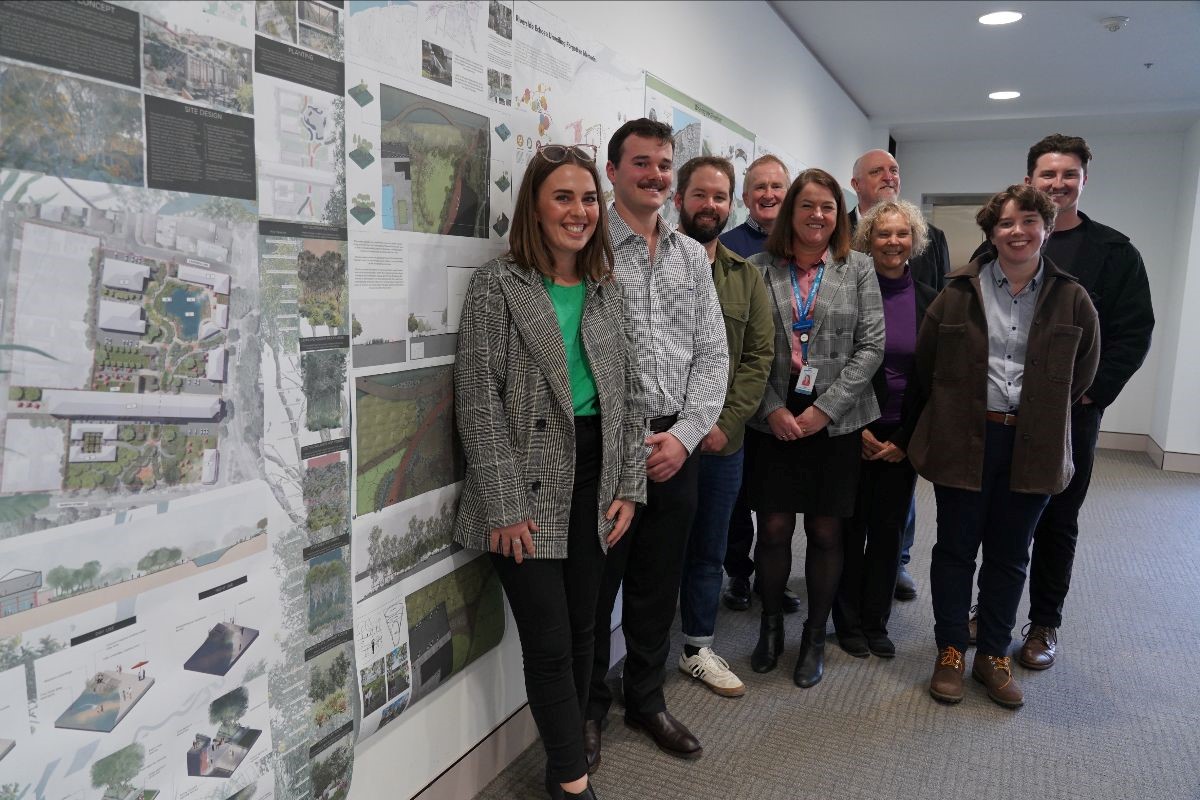UC students generate ideas for Nowra riverfront revitalisation
Published on 10 September 2024

When Professor of Landscape Architecture Gay Williams was on the hunt for a practical learning project for her second, third, and Honours year students, she discovered the Nowra Riverfront Revitalisation Project.
The Shoalhaven City Council were seeking innovate ideas to transform their local spaces – and Gay had an idea.
“I was looking for a good project for our students to explore, and reached out to the Shoalhaven City Council. They were very enthusiastic about the students getting involved,” she says.
“It would be mutually beneficial – UC students would gain rich, real-world learning experience, and the Shoalhaven City Council would generate a greater variety of ideas for their project.”
To kick off their involvement, students travelled to Nowra and spent three days camping along the riverfront. Visiting the site in person and immersing in the local culture provided rich insights into the space, and the possibilities for its future.
Second-year Bachelor of Landscape Architecture (Honours) student, Jye Berry, a former Shoalhaven resident, realised he had an opportunity to represent the needs of locals, with potential for genuine impact.
“Shoalhaven is a high-volume tourist destination, and Nowra is often regarded as the ‘Gateway to the Shoalhaven’ but this can leave the community of Nowra feeling forgotten, particularly with regards to development,” Jye says.
A former community space along the riverfront, Moore Park, had recently been closed to enable building works on a new highway. During the trip, Jye noticed how the community were still drawn to the riverfront, using the space in a variety of ways.
“To see the number of people swimming, fishing, walking, cycling, running, sitting, and just hanging out along the river shocked me. Even with little infrastructure and open space, locals were still utilising the river as the heart of their community,” Jye says.
“So, I wanted to create a place where the Shoalhaven community could share in the beauty of their natural environment together.”
His design maximised open space, providing flexibility for a variety of community uses. He reintroduced measures to repair the health of the local environment.
“I focused on the reintroduction of native plant species and the creation of a chain of storm water filtration ponds in an effort to rehabilitate the river, whilst creating a tranquil space for the community,” Jye says.
Third year Bachelor of Landscape Architecture (Honours) student Dakota Cairnduff discovered that the Nowra riverfront was prone to flooding. Her goal became creating eco-friendly community spaces, that improved mental health and that were resilient to these environmental fluctuations.
“I designed a chain of pools that function as water retention, but that could also act as temporary swimming pools,” Dakota says.
“I utilised natural plant filtration, and designed boardwalks around the pools so users could walk or sit by.”
For the final stage of their projects, students hosted a public exhibition for the community. Their final works addressed everything from ecological concerns, river health, flood prevention, vibrant attractions, festival spaces, market prospects, and water-based recreation.
“This was an incredibly valuable project. For our students, there is great benefit in working with planning professionals to gain insight into real, local projects,” Gay says.
They’ve had the opportunity to learn about working with community, and what happens at different government levels. These are all processes and procedures they will encounter in their careers in future.
For the Shoalhaven City Council too, the input of students has been invaluable as they look to the future of the area.
“The Nowra Riverfront Precinct is a truly transformative project for our city and will realise our community’s long term vision for a refreshed, activated and engaging riverfront,” said Shoalhaven City Mayor Amanda Findley.
“We are thrilled with the range of ideas and quality of the plans presented by the students. It is truly inspiring and encouraging to know that the future of landscape design is in such good hands,” she says.
For Jye, although his work on the project has come to an end, he hopes his ideas might have some impact on the city’s future.
“Open spaces promote the physical and social interactions that the digital space is taking from us, which are crucial for building a balanced and empowered community,” he says.
“They also give people the space to spend time alone outside, recharge and unwind. They provide so many basic human rights, it’s vital we don’t lose touch with them.”
(Photo supplied: University of Canberra)